Here are the 19 Best Glute Exercises and Workouts of All Time (The Definitive Guide)

Want tighter, firmer glutes?
Heck, even I do, but (no pun intended) mostly for performance purposes like jumping higher and having greater overall strength and power.
In my opinion, there’s nothing sexier than rock solid glutes that sit well in any pair of pants (not just yoga pants). Plus, your glutes play a crucial role in supporting your lower back. In fact, I consider them the “abs of your back”.
[Related Article: How to Get Abs: The Belly-Blasting, Stomach-Sculpting Trifecta]
If you choose to add these 19 glute exercises into your workouts, your lower body will have better shape and be able to produce more power (which is good for overall performance). I’ll even give you a few different glute workout ideas to help you do just that… so keep reading.
Before jumping into these workouts, I feel it’s my duty to help you understand how the glutes actually work. This is important because your “butt” isn’t just one big muscle.
Your “gluteal” muscles are actually 3 distinct muscles that each play a different role and are activated to differing degrees based on your body position, exercise used, and its range of motion. This will be important to understand once we get into what I believe are the 19 best glute exercises down below.
The Big 3 “Gluteal” Muscles
1. Gluteus Maximus
Did you know your gluteus maximus is the largest muscle in the human body? The reason it’s so large and powerful is because it has the job of keeping your torso in an erect posture.
As its name implies, it is the largest and most superficial (closest to the surface) of the 3 gluteal muscles.
The function of the gluteus maximus is primarily upper leg (thigh) extension, such as moving the upper leg backward—think rising from a squat position. Another way of thinking about this is bringing the torso upright after being hinged forward. Think of a kettlebell swing and you’ll get a good visual for the major action of the gluteus maximus muscle.
Hip extension is also prominent during deadlifts, the push-off in sprinting (and skating), and simply extending the thigh backward in any leg swing type of activity (ie. cable kickbacks).
This muscle also rotates your leg externally—think foot moving into a “duck walk” position.
2. Gluteus Medius
This muscle sits directly underneath the gluteus maximus and mostly serves to stabilize your pelvis (hips), especially when standing on one leg. Thus, when you walk or run (which is a cyclical 1-leg activity) or walk up the stairs, gluteus medius fires to prevent the pelvis from dropping to the opposite side.
Additionally, the gluteus medius (and minimus) work to abduct the thigh (move it away from the body).
3. Gluteus Minimus
This is smallest of the 3 gluteal muscles and it’s situated immediately beneath the gluteus medius. It mostly acts as a hip stabilizer. Other than that, it works together with the gluteus medius.
Hopefully that brief anatomy lesson didn’t have you glossing over. But the good news is that’s all you need to know to understand what makes an exercise a great glute exercise. With that said, let’s get into…
The 19 Best Glute Exercises of All Time
If you only did these 19 exercises, your glutes would be in amazing shape. There’s no need to use silly exercise machines to train your glutes. These 12 “smart” glute exercises are the best of the best.
Exercises for the Gluteus Maximus:
1. Quadruped Hip Extensions

The American Council on Exercise (ACE) did a study out of the University of Wisconsin to discover which exercises were most effective at activating the glutes. And guess which one came out on top for gluteus maximus activation?
You guessed it… quadruped hip extensions.
This graph shows the results along with other notable glute exercises (already mentioned in our list here): (1)
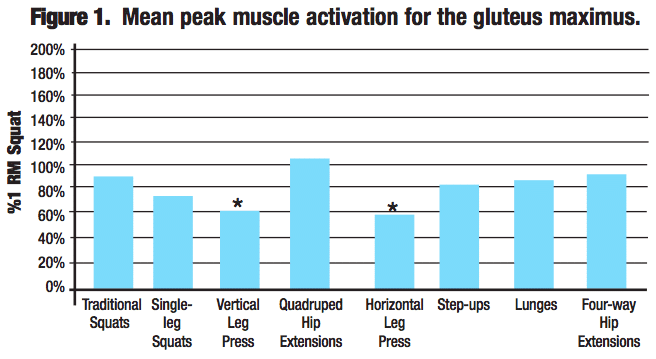
How to do it:
Get on your hands and knees, keep your back neutral, and abs braced. Take your leg right and drive it upwards keeping the knee at a 90-degree angle throughout the movement and so the foot faces the ceiling and the hip, thigh and knee are all in alignment and parallel to the floor. Lower back down and repeat for all reps before switching sides.
Notes:
- It’s essential to AVOID arching your back. Also remember to keep your neck in line with your spine – straight (thus looking down) not up.
- To make this exercise harder, add ankle weights, hold a light dumbbell behind the knee, or use a quadruped hip extension if your gym has one.
2. Kettlebell Swings
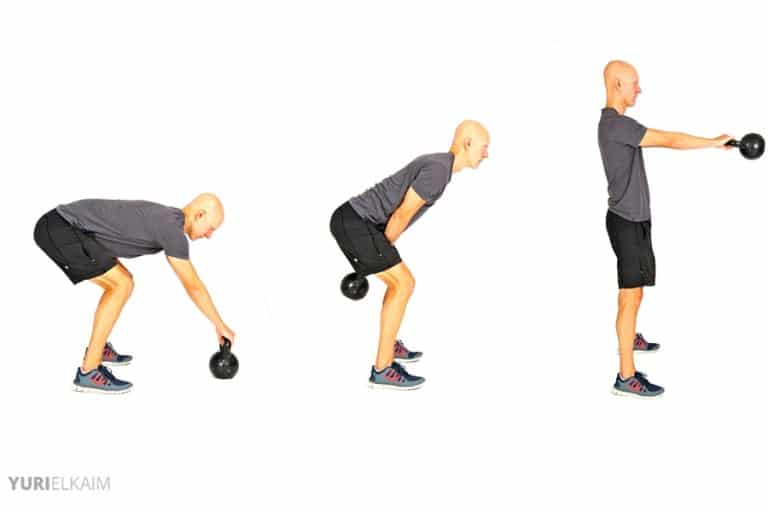
Famed spine mechanist, Dr. Stuart McGill, has shown that kettlebell swings is not only an amazing workout for activating the gluteus maximus, but they’re also one of the safest exercises you can do because they impose little to no stress on your back. (2)
If I were stranded on a deserted island and could only do one exercise, it would definitely be the kettlebell swing. It’s that beneficial.
How to do it:
With your back flat and core engaged, lean forward and place both hands on the kettlebell. Your feet should a bit wider than hip-distance apart. Maintain a slight bend to the knee and drive the hips back. Then, in a fluid motion, explosively drive the hips forward while swinging the kettlebell, keeping the glutes and core engaged.
Notes:
The motion should come from the hips, not the arms nor the quads (this isn’t a squat), as the body returns to standing. Lower the weight back down between the legs and keep this swinging motion going for desired reps.
[Related Article: 14 Kettlebell Exercises for Weight Loss]
3. Deep Squats

A study in the Journal of Strength & Conditioning Research showed that compared to partial-and parallel-depth squats, a deep squat provide far greater activation of the gluteus maximus, especially in the pushing (concentric) phase. (3)
This makes sense… since the deeper you go (assuming good form with no pelvic tilt) the more you stretch, and thus activate, your glutes. Squats that only go part of the way tend to be more reliant on the muscles of the quads, not the glutes. So go deep for greater glute involvement.
How to do it:
Begin with the barbell supported on top of the back of your shoulder (ie. your traps). Stand chest proud and head facing forward and keep your feet a little wider than shoulder width apart with the feet slightly turned if needed.
Brace your abs and lower your bum back and down (as if sitting into a chair) keeping the weight in your heels and go below parallel as long as your back stays straight through the entire range of motion. Meaning, your pelvis shouldn’t tilt as you go low – if it does don’t go as deep.
Return to standing by pushing your heels into the ground to drive yourself up and focus on engaging your glutes as you push up to standing.
4. Deadlifts

The deadlift isn’t just a good glute exercise, it’s one of the best overall exercises you can do for developing greater lower body strength and power. Obviously, you need to focus on doing it right because it can cause serious damage if you do it to failure (thanks CrossFit) or with poor form.
How to do it:
Stand close to the bar so your shins graze the bar and that it is centered over your feet. Your feet should be about hip-width apart. Bend at the hip to grip the bar at shoulder width and ensure that your back is flat and core is braced.
Lower your hips and flex the knees, keep your chest up and your back flat, and begin driving through the heels to move the weight upward.
After the bar passes the knees aggressively pull the bar back, driving your hips forward in a hip thrusting motion.
Lower the bar by bending at the hips and guiding it to the floor, ensuring that it stays close to your body to reduce any excess load on your low back.
5. Romanian Deadlifts
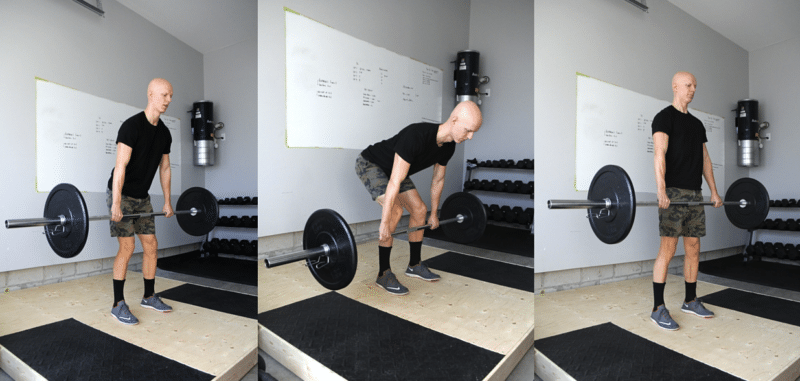
These guys are different than traditional deadlifts in that your legs are more or less fixed throughout the lift. Your knees are slightly bent, but this is mostly a “pulling” exercise initiated by the hamstrings and glutes. It likely is more focused on your hamstrings but they need to be strong as well to make you a stronger and more shapely human.
How to do it:
Hold a bar at hip level with a pronated (palms facing down) grip. Your shoulders should be back, your back straight, core braced, and your knees slightly bent. This is your starting position.
Lower the bar by moving your butt back as far as you can. Keep the bar close to your body, your head looking forward, and your shoulders back. Lower to the point where you reach the maximum range of your hamstring flexibility—usually just below the knee.
At the bottom of the movement, squeeze your glutes and pull with your hamstrings to drive your hips forward to stand up tall.
6. Knee Tuck Hip Bridge
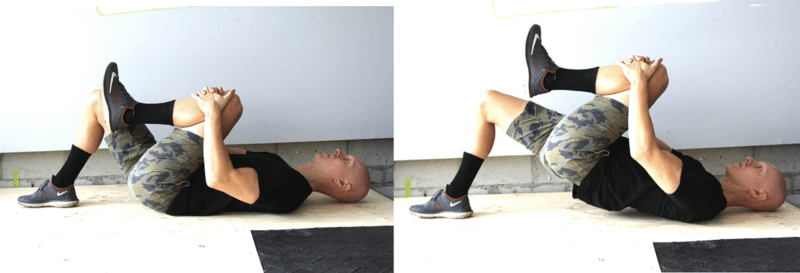
This is an advanced version of the basic hip bridge and I like it better because it opens up your hip flexors while also engaging your glutes more intensely.
How to do it:
Lay on the floor with your feet flat and knees bent. Raise your left leg off of the ground and pull it into your chest. This is your starting position.
Execute the movement by driving through the heel of your right food, extending your hip upward and raising your butt off of the ground. This will focus on the right glute. Extend as far as possible, pause and then return to the starting position. Once you’ve completed all reps on the right side, switch legs and repeat on the leg.
7. Step Ups
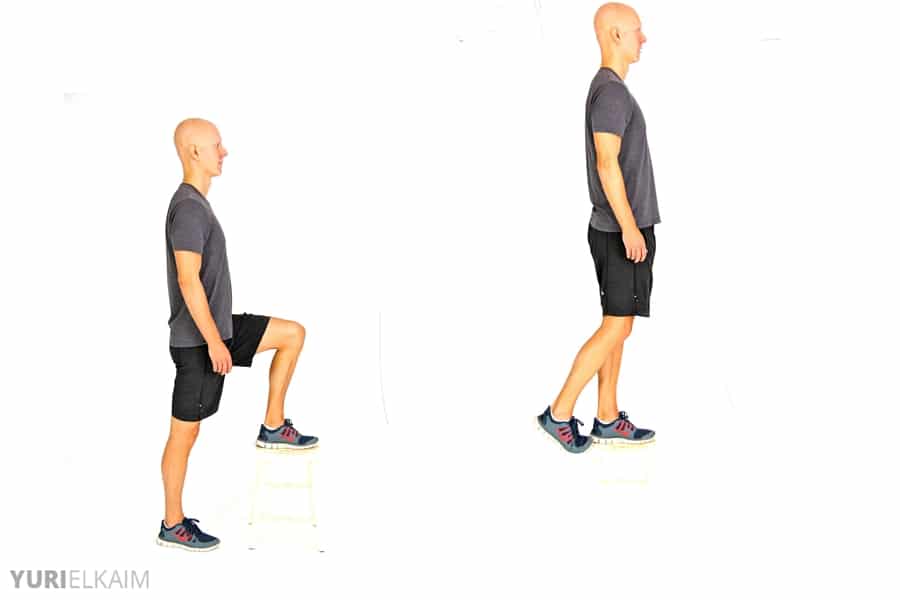
Step-ups are like doing a 1-leg squat. In fact, many Eastern bloc powerlifters have moved away from exclusively doing back squats to doing more step-ups because of how beneficial they are for developing single leg strength without the stress on your back.
How to do it:
You can do step-ups with either a barbell over your shoulders or while holding dumbbells. I’ll describe the latter here.
Stand up straight while holding a dumbbell on each hand. Keep your shoulders back and down and arms solid as they hold the weights. You should feel like a cement block from your waist-up.
Place the heel of your right foot on the box or bench. Step up by pushing into your right heel and driving yourself up in a standing position atop the box/bench. Step down and repeat with other leg.
8. Hip Thrust
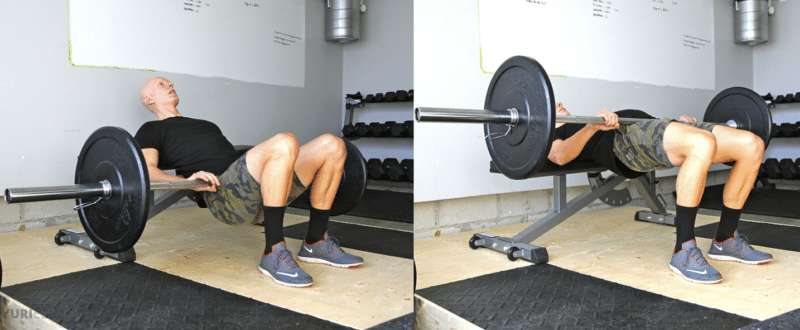
The hip thrusters are arguably the best exercise for the gluteus maximus. It elicits much more muscle activity in the gluteus maximus as a barbell squat or deadlift and that’s primarily because 4 unique characteristics of this exercise:
- The hip thrust is primarily a hip extension movement
- The hardest part of the hip thrust is at the top, which means more activation at full hip extension (ie. top of the movement where body is in straight line)
- The hip thrust retains a bent knee throughout, which keeps the hamstrings out of the movement
- The exercise only involves a small amount of knee movement
The hip thrust also involves less loading on the spine than barbell squats, as the barbell is not placed on the back but on the front of the hips. This makes the hip thruster very useful for people who are rehabilitating an injury.
How to do it:
Begin seated on the ground with a bench directly behind you. Have a loaded barbell over your legs at your hips. To save your hip bones, I would suggest using a pad on the bar. Next, lean back against the bench so that your shoulder blades are near the top of it.
Begin the movement by driving through your heels, extending your hips upwards through the bar. Your weight should be supported by your shoulder blades and the heels of your feet. Extend as far as possible, then reverse the motion to return to the starting position.
9. Cable Kickbacks
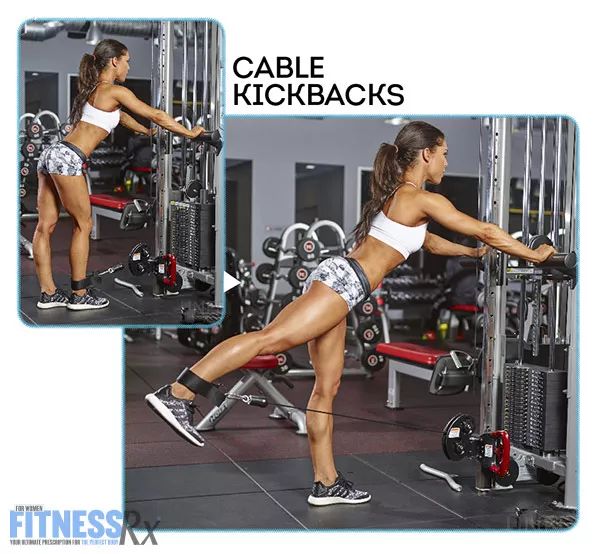
These aren’t just reserved for a Cindy Crawford workout. Cable kickbacks are a great exercise for hitting many different muscle fibers in the glutes because of the large degree of movement you get by using the cable machine.
How to do it:
Hook a velcro cuff to a low cable pulley and then attach the cuff to your right ankle. Face the weight stack from a distance of about two feet, grasping the frame for support. Keep your knees and hips bent slightly and your abs tight, contract your right glutes to kickback the leg. Slowly bring your working leg forward, resisting the pull of the cable until you reach the starting position. Repeat for required reps, then switch legs.
To hit a different set of glute fibers, externally rotate your leg (toes out) and kickback.
10. Single Leg Lateral Drop Squat
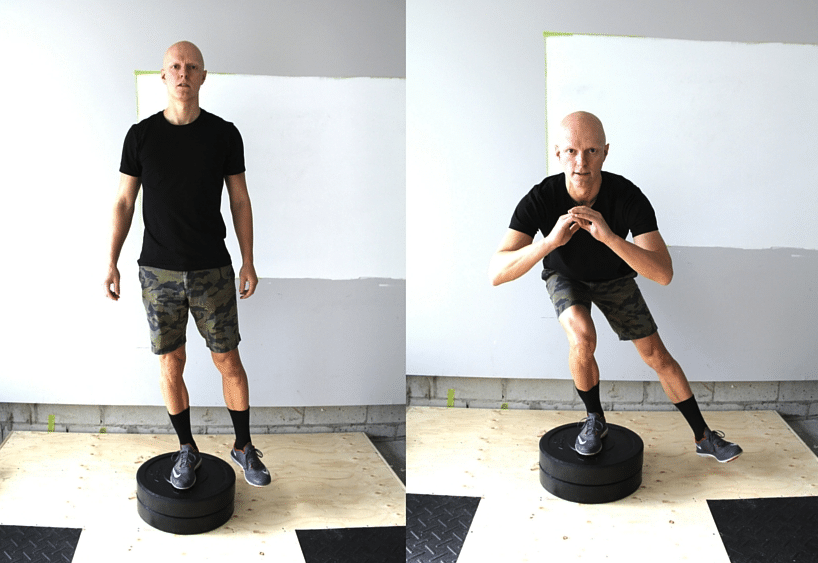
This a deceiving glute exercise. The key to this exercise is that your leg is out to the side. This shifts your body’s balances and imposes more work on the working glute. Try it and you’ll see what I mean.
How to do it:
Stand on top of a box or bench with your weight supported by your right leg, raise your left slightly out to the side so it hovers off the box/bench, then sit back into a squat on your right leg. Push through your heel and engage your posterior to return back to standing. Repeat for required reps then switch sides.
[Related Article: The 15 Best Bodyweight Exercises for Burning Fat]
11. Bulgarian Lunges/Split Squats
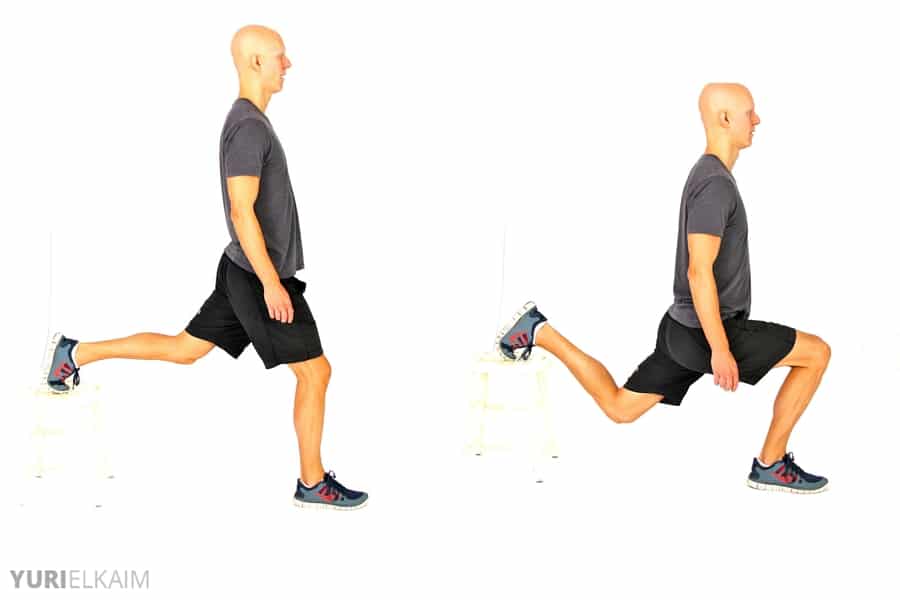
One of the most challenging and rewarding leg exercises that will develop all of the muscles in your upper leg, not just your glutes. Play around with placing the top of your foot (your laces) vs. your toes on the bench behind you. You’ll feel a day and night difference between the two.
How to do it:
For this exercise you can use a barbell overtop your shoulders or hold dumbbells by your side. I’ll describe the latter.
Stand lunge-length in front of a bench making sure your knee does not extend past your toes. Hold a dumbbell in each hand and rest the top of your left foot on the bench behind you. Lower your body until your rear knee nearly touches the floor and your front thigh is parallel to the floor. Then push through the heel of your front foot to return to standing, keeping the back foot on the bench. Repeat for required reps then switch legs.
Exercises for the Gluteus Medius (and Minimus)
Because the muscle fibers of gluteus medius and minimus have different insertion and attachment points and run at different angles than the gluteus maximus, they naturally perform different functions.
They’re main role is stability of the pelvis and moving the leg away from the body. The following exercises do just that.
12. Hip Hikes
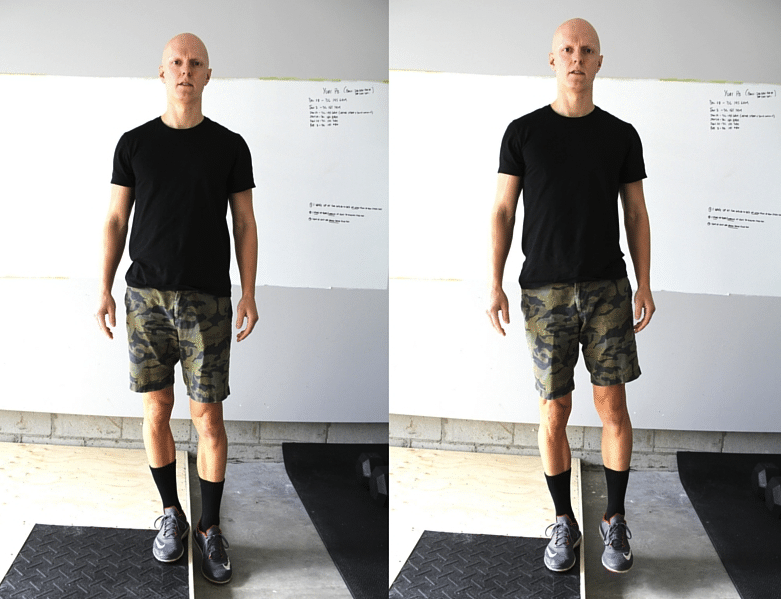
This is a great prehab exercise for waking up your “glute medes” (as I call them) and to help train your pelvis to better stabilize itself while on one leg. This is an imperative exercise for athletes, especially runners.
How to do it:
Begin in a standing position with one leg planted firmly on a slightly elevated surface – like a step. Raise the opposite hip and pelvis by hiking your hip towards the sky. Hold for 3-5 seconds. Slowly lower your hip and pelvis down towards the floor. Repeat this exercise as many times as you can until you feel fatigue (1-2min), then switch sides. Ensure the standing leg is straight and do not sway your shoulders side to side.
13. Side Lying Clams

Do you have tight IT bands? Most people do. And part of the reason is because of its originating muscle – the “tensor fascia lata (TFL)” – which resides at the top and side of your leg, just a few inches down from your hip bones.
One of the goals with glute training is to ensure you’re doing the best exercises that maximally activate your butt and NOT the TFL. Since these muscles are so close together, unless you have a solid understanding of anatomy it’s hard to tell one from the other.
But good news: a study in the Journal of Orthopaedic & Sports Physical Therapy revealed that, along with quadruped hip extension and bridging, the “clam” is one of the best glute exercises for getting maximal gluteus medius activation with minimal TFL involvement. Booya! (4)
Now, you might get some funny looks by others when you do this but who cares… they have no idea how beneficial this exercise is for strengthening your gluteus medius and minimus.
How to do it:
Lie on your left side. Rest your head on your left arm. Bend your hips to approximately 45 degrees and bend your knees at 90 degrees. Make sure one hip is lying above the other so your knees are stacked perfectly and your feet are aligned with your back. Now, float the upper leg upwards while keeping your feet in contact with one another, then return. Repeat for required reps, then switch sides.
Avoid twisting your body open as you open into your clam.
14. Band-Resisted Hip Abduction Squats
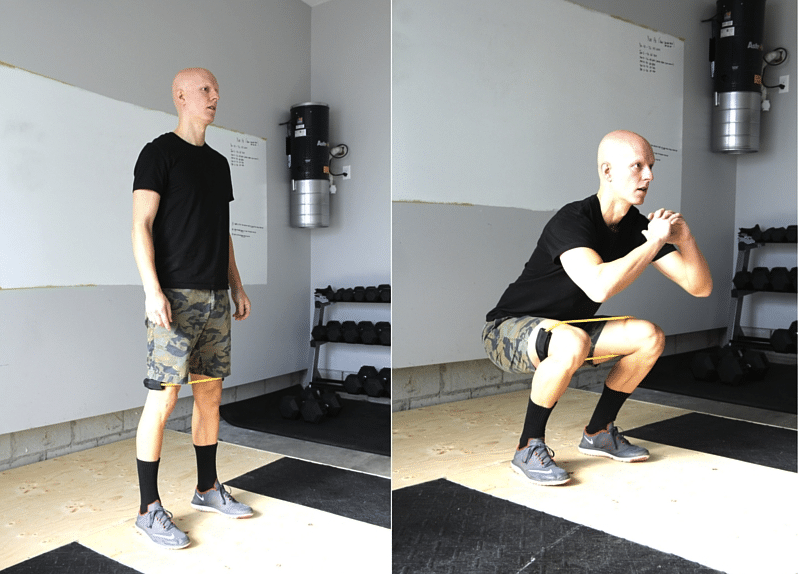
This is an amazing exercise for helping you squat more effectively. A lot of people cave their knees when squatting which is a big warning sign for potential problems including ACL tears, especially in women.
Because the resistance band is placed just above your knees, it helps to activate your gluteus medius/minimus, which work to prevent your knees from buckling in against the band’s pull. Master this exercise with only your bodyweight before attempting to do it with traditional weighted squats.
How to do it:
Place a small resistance band loop around your legs, just above your knees. Stand chest proud and head facing forward and keep your feet a little wider than shoulder width apart so that you feel the tension in the band.
Brace your abs and lower your bum back and down (as if sitting into a chair) keeping the weight in your heels and sink down into your squat. Keep tension against the band using your glutes so that your knees stay parallel the whole way through.
Return to standing by pushing your heels into the ground to drive yourself up and focus on engaging your glutes as you push up to standing, still with your knees parallel.
15. Side Plank with Leg Lift
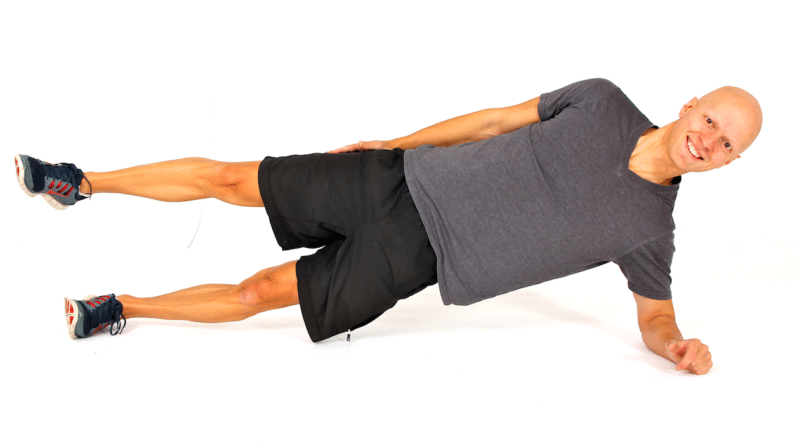
This is an advanced version of the side plank that will train both your core and your glutes. It’s pretty challenging and you’ll definitely notice discrepancies between sides.
[Related Article: The 10 Worst Ab Exercises That Waste Your Time and Kill Your Spine]
A 2009 study showed that among various glute exercises, side lying abduction exercises – similar to the leg lift in this exercise – are the most beneficial at activating your gluteus medius. (5)
How to do it:
Lie on your left side and position yourself so that your bottom forearm is directly under your armpit and your legs are straight with feet stacked. Brace your core and lift your hips in the air, forming a straight line from ankles to shoulders. Next, raise your top leg, without bending your knee, a few inches into the air. Hold for 3-5 seconds, lower the leg, and repeat. Complete required reps then switch sides.
16. Band-Resisted Lateral Shuffle
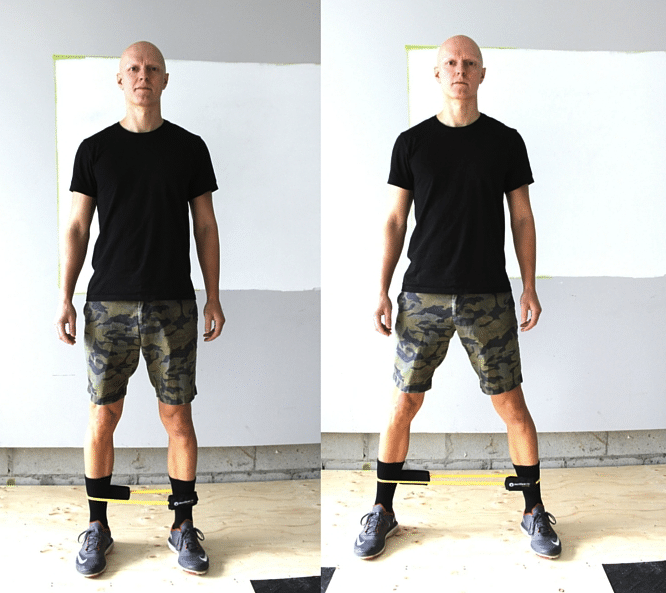
The easiest way to think about this exercise is to picture a zombie moving sideways. It looks funny but you feel your glutes catch on fire in seconds.
How to do it:
Loop a resistance band around your ankles. Make sure that it provides good tension even while your feet are just shoulder width apart. Keeping your legs straight, step out to your right (activating your right glute) and bring your left leg in slowly. Continue shuffling to the right for required reps (or distance), then return to the left.
17. Toe Touch to Knee Drive Hold
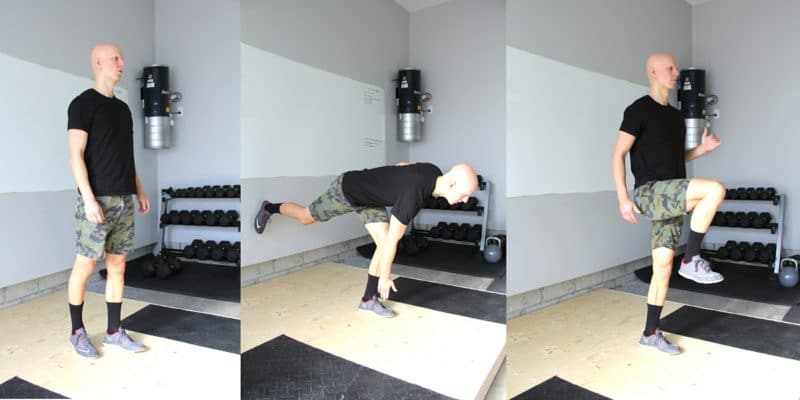
This is an exercise I used to do with my soccer athletes. It’s a terrific exercise that focuses on stability as you drive your knee through and up toward your chest, which is why I recommend it for anyone who runs – oh wait, that’s all humans!
How to do it:
From a standing position on your left foot, hinge forward from your hips keeping your back flat and right leg in straight behind it, and core braced. Reach your right hand toward your left foot. Then, engage your glutes and hamstrings on your left leg to drive yourself back up to standing and swing your right knee up and through toward your chest. Stand as tall as possible and hold that end position for 2-3 seconds before repeating. This entire exercise is about “sticking” the knee drive hold at the end, so don’t rush through it. Repeat for required reps, then switch sides.
18. Standing Leg Circles
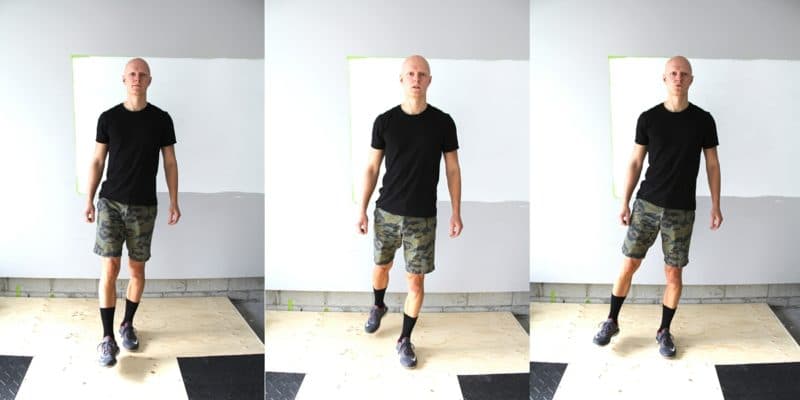
As you do this warm-up-like exercise you might be wondering how the heck it trains your glutes. But don’t worry, do a few circles or speed them up (while under control) and you’ll see why they’re included here.
How to do it:
From a standing position, balance yourself on your left leg. With your right leg straight and slightly off the floor, perform small circles (from the hip) in front, to the side, and then behind you. Aim for 3-5 circles both clockwise and counterclockwise at each angle. Your supporting leg glutes will be firing to stabilize your pelvis so be sure to stand tall and strong – no swaying.
19. Stability Ball Lateral Crab Walks

An odd exercise that will integrate both sides of the back of your body in it’s natural “cross-pattern” activation. Basically, when one glute fires, the opposing low back muscle fires as well. This naturally happens when walking, running, or walking up stairs. It’s a great exercise for this muscle firing pattern and to get your glutes working hard. Plus, it looks cool.
How to do it:
The ball should be under your head and shoulders and feel like a pillow, while your arms are outstretched to the side and fully engaged/contracted.
As with all of these stability ball exercises the key with this one is to ensure that your hips are up and your body is in a straight line from your knees to your shoulders.
Enter your glutes, which in their contraction extend (or push) your hips up.
As you move laterally a few inches to the left, you’ll instantly feel your right glute contract big time.
You’ll also notice the left side of your lower back fire up as well, which reminds us of the intricate contralateral (cross) connection between our glutes and low back.
4 Recommendations for a Well-Balanced Body
As with any type of training, variety is key. Thus, don’t just take one of the above exercises and beat it to death. Mix things up.
Every muscle has numerous muscle fibers that are stimulated by different movement patterns. By using a variety of glute exercise you will ensure you hit all of them.
With that, here are 4 recommendations when choosing glute exercises for your workouts. On a regular basis, ensure you:
- Perform at least one type of hip thrust movement (ie. hip thrust, kettlebell swing)
- Perform a variety of squatting (ie. deep squats, lateral drop squats)
- Perform a deadlifting movement (ie. deadlifts, Romanian deadlifts)
- Perform a stability-based exercise to keep your gluteus medius/minimus active and healthy
3 Butt-Sculpting Workouts for Glutes That Get Noticed (and a Stronger Body)
Now that you know the best glute exercises to do, here are 3 ways you can put a number of them together into a workout that will sculpt, shape, and strengthen your glutes.
I’ve labeled each workout based on its primary objective:
Note:
RM = “repetition max”, which means choose a weight that only allows you to do the number of reps suggested
Glute Workout 1 – Athletic Development
The focus with this workout is strength and power development. Thus, we won’t be speeding through each exercise. Instead, challenge yourself to lift heavier with fewer reps and excellent form. Take 1-3 minutes rest between sets and exercises so you’re able to give 100% effort on each one.
Perform 2 sets before moving on to next exercise. Allow 1-3 minutes rest between sets.
- Kettlebell Swings – 10 RM
- Deadlifts – 6 RM
- Deep Squats – 6RM
- Quadruped Hip Extensions – 10RM per leg
- Hip Thrust – 6 RM
Glute Workout 2 – Shape and Tone
This workout is designed for those (I guess, mostly women) who want shapely glutes that are firm to the touch and fit beautifully into any pair of jeans.
- Knee Tuck Hip Bridge – 10 reps per leg
- Band-Resisted Lateral Shuffle – 10 shuffles each way
- Quadruped Hip Extensions – 10RM per leg
- Step Ups – 6RM
- Romanian Deadlifts – 10 RM
- Cable Kickbacks – 10RM per leg
Glute Workout 3 – Prehab to Bulletproof Your Back
This workout should really be done by everyone at some point in their training plan because of how important these fundamental stabilization movements are for optimal human movement and performance.
I’ve also labeled it as being beneficial for bulletproofing your back because that’s what happens when you get your glutes (all of 3 of them) firing properly. Remember, your glutes are the “abs of your back” so the healthier they are, the better off you’ll be, especially if you sit on your butt all day.
- Hip hikers – 10 reps per leg
- Clams – 10 reps per leg
- Standing Leg Circles – 3 rounds (at each angle) per leg
- Toe Touch to Knee Drive Hold – 10 reps per leg
- Band-Resisted Hip Abduction Squats – 10 bodyweight reps
- Knee Tuck Hip Bridge – 10 reps per leg
- Stability Ball Lateral Crab Walks – 5 reps on each side
What to Do Next?
I hope you’ve enjoyed this definitive guide to glute training. Everything you need to get great glutes is in the paragraphs above. If you’ve enjoyed this article, then pick 3 friends with whom you’d like to share it and then share it with them.
You could be a hero to your friends helping them go from “saggy or flat bum” to feeling proud of what they see in the mirror. Or this could also save many people you know from potential back problems. Be a good friend and share the love.




